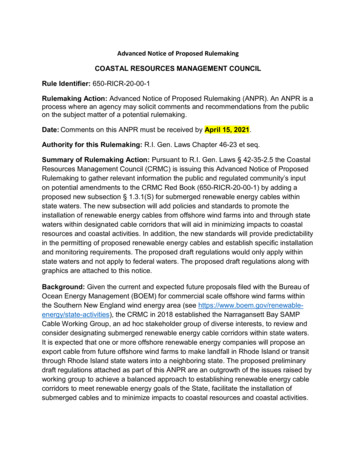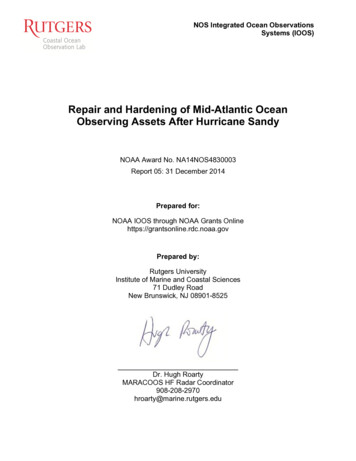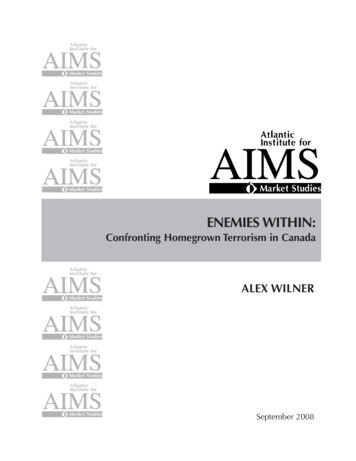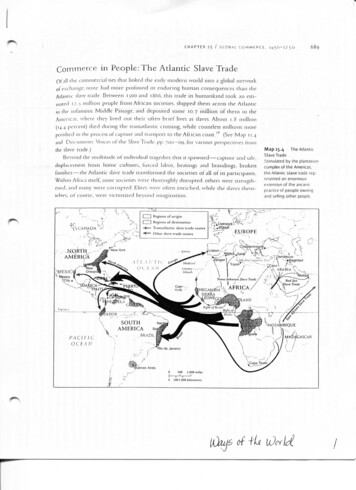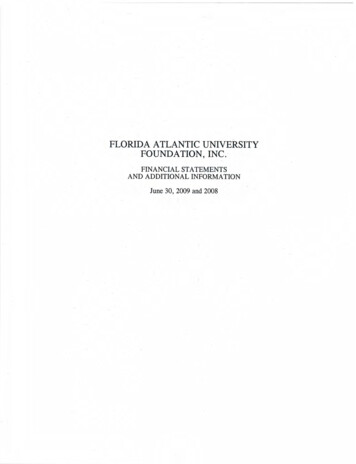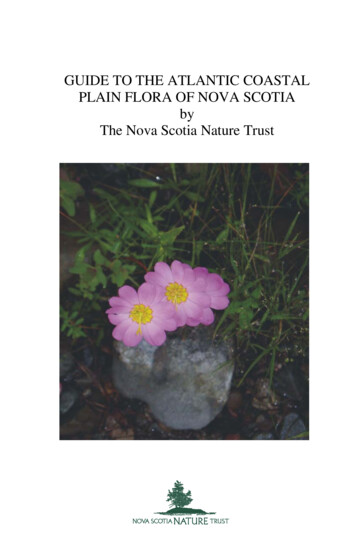
Transcription
GUIDE TO THE ATLANTIC COASTALPLAIN FLORA OF NOVA SCOTIAbyThe Nova Scotia Nature Trust
This Guide book was prepared by the Nova Scotia NatureTrust. Charlotte Keen, Lauren Allen and Duncan Bayneprepared the text and photo images. Elizabeth Kingslandcreated the line drawings that accompany some of thephotographs. Peter Green assembled the distribution maps.We are very grateful to the following individuals and organizations forgenerously permitting the use of their plant photographs.Atlantic Coastal Plain Flora Recovery TeamCharles Cron - NS Wild Flora SocietyConnecticut Botanical SocietyTom Herman - Acadia UniversityPat Kipping - O Beautiful Gaia ProjectJennifer Lusk and Eric Kershaw - Acadia UniversityJeffie McNeil – Acadia UniversityRuth Newell - Acadia University and the ACPF Recovery TeamAlex Wilson – Nova Scotia Museum, CollectionsThe Nova Scotia Nature Trust is a non-government, charitable organization dedicated toprotecting ecologically significant areas of private land in the province. Since 1994, wehave worked with landowners to protect over 2600 acres of conservation lands in NovaScotia, including unspoiled lakeshores, old-growth forests, pristine coastal islands, andimportant wildlife habitat. The Nature Trust also has a mandate of public education toincrease awareness of, and support for, land conservation. The Nature Trust is activelyprotecting critical habitat for Atlantic coastal plain species, as well as other endangeredspecies.
AcknowledgementsWe thank the Blanding’s Turtle Recovery Team, Sean Blaney, John Gilhen,Dave MacKinnon, Marian Munro, and Ruth Newell for their helpful reviews ofan earlier version of this guide that greatly improved the manuscript.The production of this guide was made possible through the generous supportof: the Nova Scotia Habitat Conservation Fund (contributions from hunters andtrappers), O Beautiful Gaia Project, the RBC Foundation, the F.K. MorrowFoundation, and Aveda Inc. Nova Scotia Nature Trust 2005No part of this publication may be reproduced or used in any way for commercialpurposes without the prior written permission of the Nova Scotia Nature Trust.
INTRODUCTIONThe Atlantic Coastal Plain FloraSouthwest Nova Scotia is home to a unique group of flowering plants knownas Atlantic coastal plain flora. These plants are one of the most endangeredplant groups in Canada. Of the sixty-four species, eleven are extremely rareand listed as either nationally endangered, threatened or of specialconcern by the Committee on the Status of Endangered Wildlife in Canada,and are found in Canada only in Nova Scotia. Five species are considered to beglobally threatened, and twenty-five are listed as at risk or sensitive bythe Nova Scotia government (see List of Coastal Plain Flora, page 6).Coastal plain plants probably colonized Nova Scotia following the last glacialperiod, 10,000 – 14,000 years ago. About 14,000 years ago most of mainlandNova Scotia and parts of the continental shelf were covered by a kilometerthick ice sheet. Sea level was about 60m lower than it is today, as water waslocked up in the ice. Therefore much of the now water-covered area betweenNova Scotia and Massachusetts was land. Plants invaded this exposed landand followed the retreating glaciers northward. Later as climate becamewarmer, melt water from the glaciers caused sea level to rise and the coastalplain flora in Nova Scotia were cut off from their mainland populations to thesouth. These Nova Scotia plants, now at their northern geographical limits,have survived amongst more aggressive and robust plant communities, and arenow found in isolated pockets in southwest Nova Scotia. The Nova Scotiacoastal plain habitats are amongst the least disturbed in North America (Fig.1).Coastal plain plants are found predominantly on the shores of freshwater lakes(Fig. 2) and in bogs; a few species also occur on streamsides and estuaries.Coastal plain flora have been unable to colonize new habitat and survivedisturbances due to three main factors: the plants are tightly constrained in thekind of habitat that they can occupy, few seeds are produced, and humandisturbance has taken a high toll on their fragile wetland habitats. Becausemany coastal plain species are small and slow-growing, competition with larger,faster-growing plants is difficult. Instead, they survive in relatively extremehabitats, such as wet areas where environmental conditions are too severe forother plants to survive. Frequently, they are found along the gently slopingsand or gravel shores of low nutrient lakes, where seasonal changes in waterlevel and exposure of the shoreline to wind, waves and ice reduce competitionfrom plants that are unable to withstand periodic flooding and low nutrientlevels. Low seed production limits the ability of these flora to spread and toregenerate.The most serious problem for the survival of this fascinating group of plants ishuman activity that threatens their critical wetland habitats. Human disturbancetakes a variety of forms such as hydroelectric dams which stabilize water levelsand allow aggressive shrubs to invade coastal plain habitat; and improper-1-
logging practices and sewage disposal which increase nutrient runoff and allowstronger competitors to invade coastal plain habitat. At the present time,however, the greatest impacts are from residential development and itsassociated uses. Plants damaged by trampling, cottage development, shorelinealteration, and flower picking are slow to recover because growing conditionsare harsh and the plants are subject to continual disturbance. ATV use destroysfragile shoreline habitat.Current efforts to conserve coastal plain flora and their critical wetland habitatsinclude those by the Nova Scotia Nature Trust and the Atlantic Coastal PlainFlora Recovery Team. In 1998, the Nova Scotia Nature Trust developed theCoastal Plain Stewards project to work with private landowners to protect thesignificant coastal plain wetlands of these plants. More recently, through thePlants on the Edge project, the Nature Trust has extended this work, andcontinues to engage in outreach and educational activities to raise theawareness of landowners, local communities, recreational lakeshore users andothers of the value and importance of protection of this habitat. The AtlanticCoastal Plain Flora Recovery Team has a working Recovery Plan in place whichidentifies the threats faced by coastal plain flora, and outlines what must bedone to recover and support the species. Members of the team come fromgovernment, academia, industry, and non-government organizations.Clearly one of the most important activities in providing protection for theseplants is to increase our knowledge and awareness, particularly those of uswho share the lands on which the coastal plain flora live. What we understand,we can begin to protect. In a move to increase our understanding, the NovaScotia Nature Trust has produced this field guide, describing thirty of theAtlantic Coastal Plain Flora. The guide includes all of the 15 rare andendangered species found in freshwater wetlands, and an equal number of themore common species of interest (see List of Coastal Plain Flora, pg. 6). Weplan to add additional coastal plain species to future versions of this guide.Appended at the end of the guide are descriptions of Blandings Turtle and theEastern Ribbon Snake. These are two endangered reptilian species which sharethe coastal plain habitat. Hopefully you will be able to use this field guide toidentify the coastal plain plants occurring on your property or on land you visit,and take steps to protect our endangered and vulnerable plants.Ways to Help Conserve Coastal Plain PlantsMany coastal plain plants grow on the lakeshores of southwest Nova Scotia - ahabitat also favoured by cottagers, anglers, hikers, ATV users and otherrecreational users. Therefore it is especially important that we learn how toshare these places without threatening the continued existence of these plants.Several suggestions are listed below:1)Learn to recognize these plants and their typical habitats. This is thefirst step toward any attempt at conservation.-2-
2)3)4)5)6)7)8)When building wharves or boat haul-ups, beaches, or any othershoreline structure, select locations away from species of concern.Maintain septic systems in proper working order, and do not use lawnfertilizers. Nutrient-poor shorelines are important to restrictcompetition from other species.Use floating docks rather than fixed docks or beaches.Leave buffers of natural vegetation along lakeshores and waterwaysto preserve water quality, and do not put in lawns, especially thoseclose to the water.Do not drive ATVs along lakeshores or in bogs. Driving ATVs in theseareas destroys both habitat and plants.Do not introduce alien invasive plants to your property. These canout-compete coastal plain plants and take over their habitat.Get involved in activities that support the conservation of these plants.The Nova Scotia Nature Trust engages interested landowners instewardship programs that help landowners to protect rare plants ontheir land. Or, become a volunteer Rare Plant Monitor through theNature Trust and collect valuable information about the status ofcoastal plain plants in your area.FIGURE 1: Distribution of Atlantic coastal plain flora in Nova Scotia and ineastern North America (inset).-3-
Explanation of Different Ranking SystemsFour different ranking systems are used in this field guide. Rankings identifywhich plant species are at risk at provincial, national, and global levels.Included are two provincial rankings, one national ranking, and one globalranking.A national ranking for the status of species comes from the Committee onthe Status of Endangered Wildlife in Canada (COSEWIC). Speciesconsidered at risk are given a status of Endangered, Threatened, or SpecialConcern:Endangered – Any species facing imminent extinction or extirpation(local extinction)Threatened – Any species that is likely to become endangered iflimiting factors are not reversedSpecial Concern - Any species that is of special concern because it isparticularly sensitive to human activities or natural eventsFor more information on COSEWIC, visit their website at www.cosewic.gc.ca.The Nova Scotia Department of Natural Resources (NSDNR) GeneralStatus Ranking is a provincial ranking that identifies species that are at riskwithin the province. Species rankings include Red, Yellow or Green:Red – Any species that is known or believed to be at riskYellow – Any species that is known or believed to be particularlysensitive to human activities or natural eventsGreen – Any species that is known or believed to be not at riskThe Nova Scotia Endangered Species Act (NSESA) lists species that areEndangered, Threatened, and Vulnerable within the province:Endangered – Any species facing imminent extinction or extirpation(local extinction)Threatened – Any species that is likely to become endangered iflimiting factors are not reversedVulnerable - Any species that is of special concern because it isparticularly sensitive to human activities or natural eventsThe Global Ranking of a species is determined by a group of internationaland local experts. Five species of Atlantic coastal plain flora are consideredglobally at risk: Pink Tickseed, New Jersey Rush, Plymouth Gentian, Long’sBulrush, and Narrow-Leaf Golden-Rod. The remaining species covered in thisguide are not considered to be globally at risk.-4-
FIGURE 2: Typical lakeshore habitats of the Atlantic coastal plain flora-5-
List of Coastal Plain Flora and Page Number (if included)Common NameScientific NameBayberry (Northern Bayberry)Beaked-rush (BrownishBeakrush)Bladderwort (HumpedBladderwort)Bladderwort (PurpleBladderwort)Bladderwort (Small SwollenBladderwort)Bladderwort (NortheasternBladderwort)Bladderwort (ZigzagBladderwort)Blue-eyed Grass(Eastern Blue-Eyed-Grass)Bog Huckleberry (DwarfHuckleberry)Brookside AlderButtonbush (CommonButtonbushCatbrier (Common Greenbrier)Chokeberry (Red Chokeberry)Clubmoss (Southern BogClubmoss)Dwarf Chain Fern (NettedChainfern)Fringed Orchid (Southern ReinOrchid)Golden-crestGolden-pert (Golden HedgeHyssop)Goldenrod (Grass-LeavedGoldenrod)Goldenrod (Narrow-Leaf GoldenRod)Grass-pinkHudsonia (Golden-Heather)InkberryJoe-pye-weed (Joe-PyeThoroughwort)Lance-leaved VioletLilaeopsis (Eastern Lilaeopsis)Long's BulrushManna-grass (Blunt MannaGrass)Marsh St. John's-wortMassachusettes Fern (Bog Fern)Mermaid-weed (Comb-LeavedMermaid-Weed)Myrica pensylvanicaRhynchospora capitellataPages, ifIncluded8-9-Utricularia gibba-Utricularia purpurea-Utricularia radiata-Utricularia resupinata-Utricularia subulata-Sisyrinchium atlanticum10-11Gaylussacia dumosa-Alnus serrulataCephalanthus occidentalis12-1314-15Smilax rotundifoliaAronia arbutifolia(Photinia pyrifolia)Lycopodiella appressa16-1718-19Woodwardia areolata20-21Platanthera flava var. flava22-23Lophiola aureaGratiola aurea24-2526-27Euthamia tenuifolia (Euthamiacaroliniana)Euthamia galetorum-Calopogon tuberosusHudsonia ericoidesIlex glabraEupatorium dubium30-3132-33Viola lanceolataLilaeopsis chinensisScirpus longiiGlyceria obtusa34-3536-37-Triadenum virginicumThelypteris simulataProserpinaca pectinata38-39--6-28-29
Polygonum hydropiperoidesJuncus caesariensisPanicum spretum(Dichantheliumspretum)Panicum leucothrix(Dichantheliummeridionale)Panicum virgatum var. spissum40-41-Panicum longifolium (Panicumrigidulum var. pubescens)Panicum dichotomiflorum var.puritanorumCoreopsis roseaSabatia kennedyanaToxicodendron radicansPotamageton pulcherLachnanthes carolianaJuncus militarisJuncus marginatusJuncus subcaudatus (Juncussubcaudatus var. planisepalusBartonia paniculata (Bartoniapaniculata ssp. iodandra)-Screw-stem (Yellow Screwstem)Bartonia virginica-Sedge (Atlantic Sedge)Sedge (Button Sedge)Sedge (Howe Sedge)Spikerush (Capitate Spikerush)Carex atlantica spp. atlanticaCarex bullataCarex atlantica spp. capillaceaEleocharis flavescens var. olivacea(Eleocharis olivacea var. olivacea)Drosera intermedia-Drosera filiformisRosa palustrisClethra alnifolia52-5354-5556-57Eleocharis tuberculosa58-59Rhexia virginicaMyriophyllum humileHydrocotyle umbellata60-6162-63Polygonum robustius-Decodon verticillatusvar. laevigatusPlatanthera blephariglottisXyris difformisEmydoidea blandingiiThamnophis sauritus-Mild Water-pepperNew Jersey RushPanic Grass (Eaton's Witchgrass)Panic Grass (MattingWitchgrass)Panic Grass (Old Switch PanicGrass)Panic Grass (Redtop PanicGrass)Panic Grass (Spreading PanicGrass)Pink Tickseed (Rose Coreopsis)Plymouth GentianPoison-ivyPondweed (Spotted Pondweed)Redroot (Carolina Redroot)Rush (Bayonet Rush)Rush (Grassleaf Rush)Rush (Woods-Rush)Screw-stem (Twining Bartonia)Sundew (Spoon-LeavedSundew)Sundew (Thread-leaved)Swamp RoseSweet Pepperbush (CoastPepper-Bush)Tubercled Spikerush (LongTubercled Spike-Rush)Virginian Meadow-beautyWater-milfoil (Low Water-Milfoil)Water Pennywort (ManyFlowered Pennywort)Water Smartweed (StoutSmartweed)Water-willow (Hairy SwampLoosestrife)White Fringed OrchidYellow-eyed GrassBlanding’s TurtleEastern Ribbon 70-71
Common Name: BayberryScientific Name: Myrica pensylvanicaFamily: Bayberry Family (Myricaceae)Diagnostic Features:Form: Deciduous shrub with many branches; male and femaleflowers are on separate plants.Height: Up to 2.5mStems: May have glandular hairsLeaves: Lance-shaped or oval leaves that are broadest towards thetips. Leaves are glossy and sometimes have a few teeth at the apex.Catkins: Male catkins are slightly longer (1.2 cm) than female catkins(1.0 cm).Fruit: Nutlets are nearly round, occur in small clusters, and areseveral millimeters wide. They are covered in a white waxy substance.Flowering Period: JuneHabitat: Best known from coastal headlands and beaches; but in southernNova Scotia, also occurs in open swamp and boggy forest, dry rocky forest andsemi-open rocky ridges.Range: North Carolina north to Ontario, southeastern New Brunswick, NovaScotia, and NewfoundlandDistribution: Abundant in southwestern Nova Scotia; infrequent in the centreof the provincePoints of Interest: The entire plant is fragrant; crush a few leaves in yourhand!Status: COSEWIC ranking: N/ANSDNR ranking: GreenNSESA ranking: N/ANotes:-8-
Bayberry (Myrica pensylvanica). Inset: Close-up of Bayberry leaves.-9-
Common Name: Blue-Eyed Grass (Eastern Blue-Eyed Grass)Scientific Name: Sisyrinchium atlanticumFamily: Iris Family (Iridaceae)Diagnostic Features:Form: Slender grass-like perennial plantHeight: 50 cm tallStems: Wiry, two-edgedLeaves: Narrow, often spreadingFlowers: Bluish-purple with a yellow centre, enclosed by two largebracts; petals have narrow points. Flowers are 1.25 – 2 cm wide.Flowering Period: JulyHabitat: Damp, peaty to poorly drained, sandy or gravelly soilRange: Newfoundland to Ontario, south to VirginiaDistribution: Common from Yarmouth and Shelburne Counties to Lunenburg;scattered throughout the rest of the provincePoints of Interest: The flower of Blue-Eyed Grass lasts for only one day ayear, and can be seen in July.Status: COSEWIC ranking: N/ANSDNR ranking: GreenNSESA ranking: N/ASimilar Species: Similar to Common Blue-Eyed Grass (S. montanum), StoutBlue-Eyed Grass (S. angustifolium) and Slender Blue-Eyed Grass (S.mucronatum). The stems of both Stout and Eastern Blue-Eyed Grass have abract in the middle, from which the long flowering stems branch. NeitherCommon nor Slender Blue-Eyed Grass have this bract, and the stem of boththese flowers is unbranched. The stems of Stout and Common Blue-Eyed Grasshave distinct flat edges, while the stems of Eastern Blue-Eyed Grass do not.Notes:- 10 -
Blue-Eyed Grass (Sisyrinchium atlanticum).- 11 -
Common Name: Brookside AlderScientific Name: Alnus serrulataFamily: Birch Family (Betulaceae)Diagnostic Features:Form: Tall woody shrub with one or more stemsHeight: Up to 5 mStem: Most stems are up to 5 cm in diameter, but can be up to 12cm wide. Branches arch outwards from the main stem.Bark: Smooth, pale greyLeaves: Simple, alternate, oval leaves that are 4-8 cm long. Leavesare broadest toward the apex (which is the key distinguishing featurefrom our other two alders) and tapered toward the stem. Margins arefinely toothed.Female Catkins: Small catkins in groups of two to four are borne onshort branches, angled away from the supporting twig. After malecatkins fall off, females go on to become cone-like fruiting structures,8-14mm long.Male Catkins: Larger and longer than female ones, on branches thatare angled away and downward from the supporting twig. Inblooming period, are 3-5 cm long and are whitish to yellowish-greenand brown.Flowering Period: February - MayHabitat: Lakeshores and associated swampy areasRange: Florida to Louisiana, north to southern Ontario, Quebec, NewBrunswick and Nova ScotiaDistribution: Southwestern Nova Scotia, but uncommon and localStatus: COSEWIC ranking: N/ANSDNR ranking: YellowNSESA ranking: N/ASimilar Species: Similar to Downy Alder (Alnus viridis) and Speckled Alder(Alnus incana); can be distinguished by the leaves. Leaves of Downy Alder areoval, and broadest at the base; leaves of Speckled Alder are broadest at thebase or middle, and margins are more deeply toothed. In contrast, leaves ofBrookside Alder are broadest at the apex. Another feature that distinguishesBrookside Alder is the presence of cross-veins that disappear towards the edgeof the leaf. Also, the buds of Brookside Alder and Speckled Alder are on shortstalks, while those of Downy Alder lack stalks.- 12 -
Speckled AlderDowney AlderBrookside AlderBrookside Alder (Alnus serrulata). Note that the leaves are broadest towards thetip and taper towards the stem. Sketches (lower) comparing leaves of the threealder species found in Nova Scotia. Note that the buds of Brookside Alder andSpeckled Alder grow on a short stalk, while the buds of Downy Alder do not.- 13 -
Common Name: ButtonbushScientific Name: Cephalanthus occidentalisFamily: Madder family (Rubiaceae)Diagnostic Features:Form: Upright, branching shrub with woody stemsHeight: Up to 3mLeaves: The whorled leaves (3 leaves coming from same point onthe stem) are unique among our region’s shrubs. Leaves aresometimes opposite (in pairs), but in examining the whole shrub onecan always find some leaves in threes. Leaves are oval in shape andnarrowed to a point at both ends. They are 7-15cm long with a shinydark green upper surface. Veins curve towards the tip of the leaf andthe margins are untoothed.Flowers: The flowers of Buttonbush are unique: ball-shaped clustersof small, white, tubular flowers with a protruding style. Round headsare 2-4 cm in diameter.Fruit: Small, round, hard cluster of dark brown nutlets, manyremaining on the shrub after leaf.Flowering Period: July 15 – August 15Habitat: Rocky shores of lakes and rivers in moist soils; less commonly inboggy wetlandsRange: Florida to Mexico, north to Nova Scotia, southern New Brunswick,Ontario, QuebecDistribution: Along the Medway River system and upper Mersey River inQueens County; Yarmouth County; Deception Lake, Roseway River, JordanRiver, and Lake John in Shelburne CountyPoints of Interest: Buttonbush seeds are eaten by ducks, geese, andshorebirds, and many small animals use the plant for cover. The plant ispoisonous to humans.Status: COSEWIC ranking: N/ANSDNR ranking - YellowNSESA ranking – N/ANotes:- 14 -
Buttonbush (Cephalanthus occidentalis) in bloom (top), flower (inset), postbloom (lower).- 15 -
Common Name: Catbrier (Round-Leaved Greenbrier)Scientific Name: Smilax rotundifoliaFamily: Catbrier Family (Smilacaceae)Diagnostic Features:Form: Woody vine, creeping over shrubs and into trees; verybranched and strongly armed with thorns.Length: Up to 10mStem: Green, covered in green rigid thorns; attaches by curvingtendrils.Leaves: Smooth, glossy, nearly round or heart-shaped; have threemain veins.Flowers: Small, greenish; seldom seenFruit: Small bluish-black berries; seldom seenFlowering Period: Late April - JuneHabitat: Thickets, and the borders of lakes and rivers; often found growing indense piles on top of other shrubsRange: Florida and Texas, north to Nova Scotia and southern OntarioDistribution: Frequent in Digby, Yarmouth, Shelburne, and Queens Counties;rarer inland, but scattered near KejimkujikPoints of Interest: Catbrier is Nova Scotia’s only woody monocot (a group offlowering plants that can be distinguished by having parallel, unbranched leafveins).Status: COSEWIC ranking: N/A (However, the Great Lakes population ofCatbrier is considered Threatened by COSEWIC)NSDNR ranking: GreenNSESA ranking: N/ANotes:- 16 -
Catbrier (Smilax rotundifolia) vine showing thorns (upper). Note the climbinggrowth pattern of the vine (lower).- 17 -
Common Name: Clubmoss (Southern Bog Clubmoss)Scientific Name: Lycopodiella appressaFamily: Club-Moss Family (Lycopodiaceae)Diagnostic Features:Form: Prostrate, creeping perennial herb that resembles a coarsemoss.Height: 8 – 35cmStems: Densely leaved, not branched very much. Most stems liehorizontally on the substrate, but scattered upright stems exist aswell. Some stems have a 1 - 3 cm long cone-like structure at the topwhich contains the spores (called a strobilus).Leaves: Green; very small; cover the stemHabitat: Beaches, boggy savannas, wet depressions in peatlandsRange: Atlantic provinces, south to Florida, and west to Kansas and Texas;CubaDistribution: Scattered in south and southwestern Nova Scotia; Cape BretonPoints of Interest: Clubmosses are a very old group of plants closely relatedto the ferns. They are not a moss, but are often mistaken for mosses due totheir green colour and low growth form.Status: COSEWIC ranking: N/ANSDNR ranking: GreenNSESA ranking: N/ASimilar Species: Looks like Lycopodiella inundata (Bog Clubmoss), which, at aheight of up to 6 cm, is much smaller than Lycopodiella appressa. Leafy stemsof L. inundata are 0.5 – 0.9 mm in diameter, while those of L. appressa areconsiderably wider.Notes:- 18 -
Clubmoss (Lycopodiella appressa). Upper arrow points to a creeping, horizontalstem, while lower arrow shows a vertical reproductive stem (called a strobilus).- 19 -
Common Name: Dwarf Chain FernScientific Name: Woodwardia areolataFamily: Chain Fern Family (Blechnaceae)Diagnostic Features:Form: Fern with fronds (leaf, including blade and stem) divided onlyonce. Fertile fronds are different from non-reproductive fronds; eachplant has several non-reproductive fronds. Pinnae (branches of thefern blade) are not paired along the stem.Height: 45 – 60 cmLeaves: Fertile fronds have much narrower leaflets than nonreproductive fronds.Leaf Stalk: Dull green and slightly scaly on the underside.Spores: Occur on underside of leaves; arranged end to end,resembling tiny chains.Spores: July - OctoberHabitat: Along streams, swamps, bog marginsRange: Nova Scotia, rare inland to Michigan; Florida to Texas; north tosouthern New HampshireDistribution: Yarmouth and Shelburne counties; rarer inlandStatus: COSEWIC ranking: N/ANSDNR ranking: YellowNSESA ranking: N/ASimilar Species: Resembles Sensitive Fern (Onoclea sensibilis), but the frondsof Dwarf Chain Fern are finely toothed, while Sensitive Fern has wavy margins.The leaflets of Dwarf Chain Fern are narrower and less lobed than those ofSensitive Fern. Sensitive Fern has one leafy frond and a non-leafy fertile frondthat resembles an inverted bunch of grapes on a long stalk, while Dwarf ChainFern has two frond types as described above. Also, the pinnae of Dwarf ChainFern are not paired along the stem, while those of Sensitive Fern are.Notes:- 20 -
Dwarf Chain Fern (Woodwardia areolata). Fertile frond (lower), showingspores arranged in a chain-like pattern. Habitat picture of Dwarf Chain Fern(upper). Note that non-reproductive fronds are much wider than fertile fronds.- 21 -
Common Name: Fringed OrchidScientific Name: Platanthera flava var. flavaFamily: Orchid family (Orchidaceae)Diagnostic Features:Form: Slender, herbaceous perennialHeight: 2-14 cm tallLeaves: Each plant has two or more long, lance-shaped leaves whichare quickly reduced in size towards the top of the plant. The lowestleaf is 10-15 cm long, and wraps around the base of the stem.Flowers: Greenish-yellow flowers on a spike, 5-10 cm long. Eachflower is 4-5 mm wide. Flowers have roundish petals and a broad lip,usually with a small tooth on each side; lip has a small protuberancein the centre.Flowering Period: May - AugustHabitat: Sand or gravel beaches; wet woodlands, bogs, swamps, meadows;lake and river shoresRange: Florida, north to New Jersey and Nova ScotiaDistribution: In Nova Scotia, found along the Tusket River in YarmouthCounty, and the Medway River in Queens County. Also found in Kings andColchester Counties.Status: COSEWIC ranking: N/ANSDNR ranking: YellowNSESA ranking: N/ASimilar Species: Similar to Platanthera flava var. herbiola, which is stouter,with leaves that taper only slightly towards the tip and has a smaller floweringhead than Platanthera flava var. flava.Notes:- 22 -
Fringed Orchid (Platanthera flava var. flava).- 23 -
Common Name: Golden-CrestScientific Name: Lophiola aureaFamily: Bloodwort Family (Haemodoraceae)Diagnostic Features:Form: Unbranched, perennial herbHeight: About 50 cmStem: Covered in white wooly hairsLeaves: Long, narrow, erect leaves that arise from the base of theplant. Leaves are opposite and up to 30 cm long, and are green withred at the base.Flowers: The flowering stalk branches repeatedly, and is coveredwith white wooly hairs. Each stalk has a cluster of small, deep yellowflowers at the top.Flowering Period: August – early SeptemberHabitat: Cobble lakeshores, bogs, low swampy land; in a fen on Digby NeckRange: Nova Scotia and New Jersey; south to Florida and MississippiDistribution: In Nova Scotia, known only in southwestern counties, includingLunenburg, Queens, and DigbyPoints of Interest: Golden-crest gets its scientific name from the Greek wordlophia, which means mane, because of the white wooly cover on its stem andflowers.Status: COSEWIC ranking: ThreatenedNSDNR ranking: RedNSESA ranking: ThreatenedNotes:- 24 -
Golden-crest (Lophiola aurea). Flower in bloom (lower). Note white, woolycovering of flower.- 25 -
Common Name: Golden-pertScientific Name: Gratiola aureaFamily: Snapdragon Family (Scrophulariaceae)Diagnostic Features:Form: Small herbaceous plant, creeping to form patchesHeight: 10 – 30 cmStem: Smooth; may be simple or branchedLeaves: Opposite, broadly oval or lance-shaped. Leaves do not havea stalk, and the base wraps around the stem.Flowers: Bright yellow, bell-shaped flowers that are 1 – 1.5 cmacross and on a stem that is up to 2 mm long.Flowering Period: July - AugustHabitat: Lakeshores, moist areas of dry savannahsRange: Ontario; Newfoundland; Nova Scotia south to FloridaDistribution: In Nova Scotia, common from Yarmouth and Shelburne Countiesto Halifax CountyPoints of Interest: On the shores of Ponhook Lake, Queens County, there isa population of Golden-pert with a flower that is pure white, except for ayellowish tinge on the interior of the flower.Status: COSEWIC ranking: N/ANSDNR ranking: GreenNSESA ranking: N/ANotes:- 26 -
Golden-pert (Gratiola aurea) shown growing in its typical habitat. Golden-pertflowers (lower).- 27 -
Common Name: Golden-Rod (Narrow-Leaf Golden-Rod)Scientific Name: Euthamia galetorumFamily: Aster Family (Asteraceae)Diagnostic Features:Form: Erect, slender perennial plant; stem usually unbranched to thetip.Height: 1 – 1.5mLeaves: Long and thin leaves with parallel sides and 3-5 veins. Thickleaves point up, towards the top of the plant.Flowers: Bright yellow, in a flowering head 1 – 2 cm wide. There areseveral flowering heads per plant, each with 25-50 tiny flowers.Flowering Period: August and SeptemberHabitat: Lakeshores; prefers wet, peaty, or sandy soilRange: Endemic to Nov
Appended at the end of the guide are descriptions of Blandings Turtle and the Eastern Ribbon Snake. These are two endangered reptilian species which share the coastal plain habitat. Hopefully you will be able to use this field guide to identify the coastal plain plants



